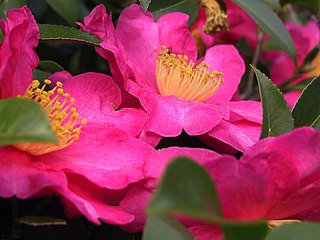
Bulguksa is located on the slopes of Mount Toham. It is a head temple of the Jogye Order of Korean Buddhism and encompasses seven National treasures of South Korea, including the Dabotap and Seokgatap stone pagodas, Cheongun-gyo, and two gilt-bronze statues of Buddha. The temple is classified as Historic and Scenic Site No. 1 by the South Korean government. In 1995, Bulguksa was added to the UNESCO World Heritage List together with the Seokguram Grotto, which lies four kilometers to the east.

The Seokguram Grotto is a hermitage and part of the Bulguksa temple complex. It lies four kilometers east of the temple on Mt. Tohamsan, in Gyeongju, South Korea. It is classified as National Treasure No. 24 by the South Korean government and is located at 994, Jinhyeon-dong, Gyeongju-si, Gyeongsanbuk-do. The grotto overlooks the Sea of Japan and rests 750 meters above sea level. In 1962, it was designated the 24th national treasure of Korea. In 1995, Seokguram was added to the UNESCO World Heritage List together with the Bulguksa Temple. It exemplifies some of the best Buddhist sculptures in the world.
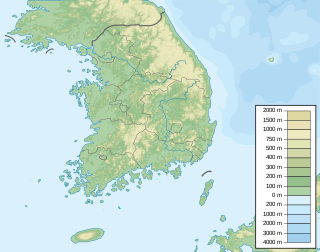
Tongdosa is a head temple of the Jogye Order of Korean Buddhism and in the southern part of Mt. Chiseosan near Yangsan, South Gyeongsang Province, South Korea.

A National Treasure is a tangible treasure, artifact, site, or building which is recognized by the South Korean government as having exceptional artistic, cultural and historical value to the country. The title is one of the eight State-designated heritage classifications assigned by the administrator of the Cultural Heritage Administration (CHA) in accordance with the Cultural Heritage Protection Act after deliberation by the Cultual Heritage Committee.
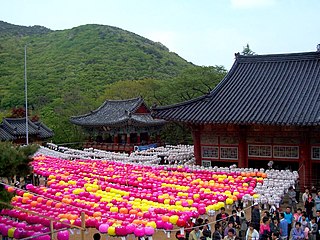
Beomeosa is a head temple of the Jogye Order of Korean Buddhism in Cheongnyong-dong, Geumjeong-gu, Busan, South Korea. Built on the slopes of Geumjeongsan, it is one of the country's most known urban temples.
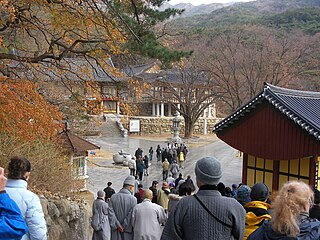
Donghwasa, also Donghwa Temple, is a Buddhist temple of the Jogye Order in northern Daegu, South Korea. The temple is located on the south side of Mt. Palgongsan, within the boundaries of Dohak-dong, Dong-gu, near Daegu's northern border. The name means "Temple of Paulownia Blossoms."

Sudeoksa is a head temple of the Jogye Order of Korean Buddhism. It is located on the southern slopes of Deoksungsan in Deoksan-myeon, Yesan County, South Chungcheong Province, South Korea.

Beopjusa is a head temple of the Jogye Order of Korean Buddhism. It is situated on the slopes of Songnisan, within Songnisan National Park, in Naesongni-myeon, Boeun County, in the province of Chungcheongbuk-do, South Korea.

Woljeongsa is a head temple of the Jogye Order of Korean Buddhism, located on the eastern slopes of Odaesan in Pyeongchang County, Gangwon Province, South Korea. Woljeongsa was founded in 643 by the Silla monk Jajang.

Yongjoosa is a head temple of the Jogye Order of Korean Buddhism. It is located in on the slopes of Hwasan in Taean-eup, Hwaseong, in the province of Gyeonggi, South Korea. The temple's name means "dragon jewel temple."

Hwaeomsa is a head temple of the Jogye Order of Korean Buddhism. It is located on the slopes of Jirisan, in Masan-myeon, Gurye County, in the province of South Jeolla Province, South Korea.

Baekdamsa (백담사) is a Buddhist temple in Inje County, Gangwon province, South Korea. It was originally built in the 7th century, but because of war and natural disasters has been rebuilt numerous times since then. The present version was completed in 1957. Additionally, the name has also changed over time. Originally called Hangyesa, the new name reflects the "100 pits from Daecheongbong Peak to the temple".

Neunggasa is a Korean Buddhist temple located in Yeongnam-myeon township, Goheung-gun County, Jeollanam-do, South Korea.
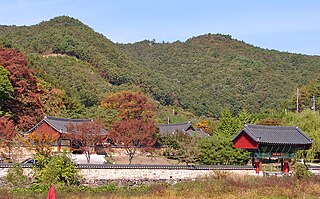
Ssangbongsa, or Ssangbong Temple, is part of the Jogye Order of Korean Buddhism located in rural Jeung Village, Iyang Township, Hwasun County, South Jeolla Province, South Korea.

Naesosa, or Naeso Temple, is a Korean Buddhist Temple located at the base of Naebyeongsan (mountain) in Jinseo-myeon, (township), Buan-gun (county), Jeollabuk-do (province), South Korea.

Yongmunsa is a Buddhist temple of the Jogye Order in Yangpyeong, South Korea.

Samhwasa is a Buddhist temple of the Jogye Order in Gangwon, South Korea.

Banyasa is a Buddhist temple of the Jogye Order in Chungcheong, South Korea.
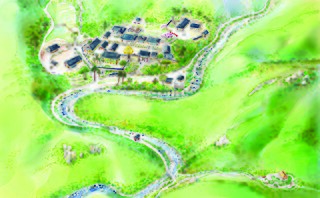
Daewonsa is a Buddhist temple of the Jogye Order in Gyeongsangnam-do, South Korea.





